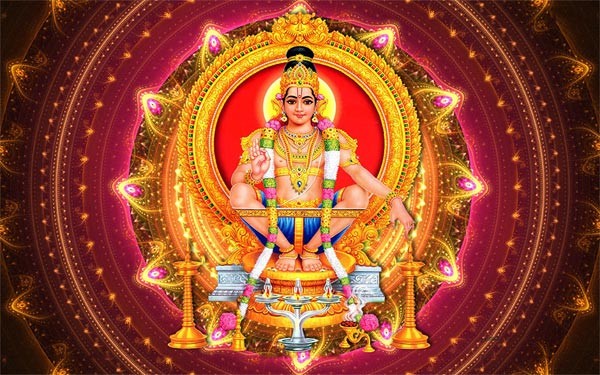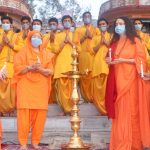Lord Ayyappa is the most famous Warrior God worshipped in South India, especially during the month of “Karthika Masam” with “Mandala Vratam”. Ayyappa is the son of Shiva and Mohini – the female avatar of Vishnu. It is estimated that over 50 million people reach the temple every year to seek blessings of the Lord Ayyappa on the day of Makar Sankranthi or Pongal. The most famous Lord Ayyappan shrine or temple is located at Sabarimala, on the hills of Pathanamthitta in Kerala, India, considered one of the largest pilgrimage sites in the world.
Who is Ayyappa?
Ayyappa is a handsome celibate god doing yoga and as an epitome of Dharma, who wears a bell around his neck. He is known as Hariharaputra, the son of Lord Vishnu, when he was in Mohini Avatar and Lord Shiva, hence he is born with the powers of both the God’s. he is also known as Manikantha and Mani as he is born wearing a necklace with “Mani”.
Another Legend says that he was raised by a childless royal couple, and grows up as a warrior yogi champion of ethical and dharmic living. In the South Indian version, Ayyappa images show him as riding a tiger, but in some places such as Sri Lanka he is shown as riding a white elephant. In the oral tradition as represented by Malayalam folk songs, Ayyappa is presented as a warrior hero of Pandala kingdom.

Legend
Ayyappa was found on the banks of River Pampa. He was adopted child to Pandala King(Rajashekhara) and cured the deaf and dumb of Teacher’s(Guru) son. Due to evil manipulations of his step mother, he went to forest and killed demoness Mahishi and came to kingdom riding on tiger for giving milk of tiger to his step mother. After that he went to dense forest and disappeared. Upon the instructions of Ayyappa, King built temple for Ayyappa in Sabarimalai. Sabarimalai means Sabari- the devote of Ayyappa and malai- the hill. Sabari, the devotee of Ayyappa had become a hill for the place of stay for Ayyappa.
There is spiritual relation existed between Lord Ayyappa and Lord Saturn. After watching troubles caused by Lord Shani to his devotees he suggested Ayyappa deeksha for 41+ days(mandalam) as remedy for all the troubles of Lord Saturn. These 41+ days Lord Ayyappa devotees experience all the difficulties to please Lord Saturn and reach Lord Ayyappa Temple by wearing black cloths as the symbol of Lord Saturn.
When Ayyappa learning war fighting tactics(Kalari Vidya) under guru panicker (last name of Kaniyars community of Kerala,who are teachers). Teachers daughter ‘Nila’ fell love with Lord Ayyappa and asked to marry her. But Lord refused to marry her by explaining his misson as Bramhachari(bachelor) to kill demon Mahishi.
Must Read : Bhadrachalam gearing up for Annual Vaikunta Ekadasi
Sabarimalai Hill
Set in the forests of the Quilon district Western Ghats on the banks of river Pambar, southeast of Kottayam, Sabarimala temple is one of the most popular pilgrimage sites in the world. The original idol at sabarimalai temple is said to be installed by Lord Parasurama. Sabarimalai hill was the place where Sabhari lived and Lord Rama visited.

To visit the temple many begin by taking a “Mandala Vrat” during the month of “Karthika Masam” till Makara Sankrathi. During the Vrath of 41 days devotees start leading a simple life, doing yoga, abstaining from sex, eating a vegetarian diet or partially fasting, wearing black or blue or sadhu-style dress. After the Mandala Deeksha, devotees trek to the Shrine. There are no caste, creed, religion restrictions for the “Deeksha”, all are welcome and equals before the God, except for the Ladies who are in the age group of 11 to 50 years. The pilgrims call each other by the same name during the trek ”Swami”, to denote that there is no difference between any person. After the long trek of about 18 miles, they bathe in the Pamba river, then they climb 18 steps at the Sabarimala shrine, each representing a dharmic value (ethics, or interiorized gods). The shrine priests and devotees bring flowers from all over the Western Ghats and scatter them near the shrine, all the while chanting shlokas.
The devotees wear simple dress on the day of the pilgrimage up the hills and through the forest, many go barefoot, carry “Irumudi”, wear Tulasi leaves and Rudraksha beads around their neck (symbolism for Vishnu and Shiva) while fellow Hindus gather along the trek path, cheering and helping them complete their journey. ‘Irumudi’ is the travelling kit of devotees which keeps worship articles such as ghee coconuts, sandal, vibhooti, jacket pieces with the wishes written on it.
The 18 steps to reach god are considered as Holy steps and indicates five senses, eight desires, 3 behaviors, knowledge and ignorance. Act of crossing these steps is considered as sacred and bestows with self-realization.
Devotees after the 41 days of “Deekksha” visit Sabarimala to have the glimpse of the Makara Jyothi. Which is considered the auspicious. Makar Jyothi is a star which is worshiped by devotees as the form of Ayyappa on Makar Sankranthi day. Makara Vilakku is sacred fire which appears on the top of hills near by the temple. Thiruvaabharanam are the sacred gold ornaments of Ayyappa which are carried to temple before Makar Sankranthi(around jan12th every year) and taken back to Pandalam temple after finishing of pilgrim season. Garuda (holy eagle) is the guardian of the ornaments.
Must Read : Karthika Msasm : Rituals that Blend Your Life
Ayyappa and other Religions
Ayyappa is revered in other religions too. In Buddhism, Ayyappa is considered to be an incarnation of the Buddha. Scholars link Buddhist influence in the ritual that Ayyappan was called as Dharmashasta or just Shasta meaning “Teacher”, as Buddha was, and the chanting of “Swamiye Saranam Ayyappa” in the Ayyapa tradition is like the “Buddham Saranam Gachami” chant of the Buddhists.
He is also revered by Muslims in Kerala due to his friendship with Vavar, who is identified as a Muslim brigand in local versions of the Ayyappa myth. In this mythology, Ayyappa confronts the plunder-driven pirate robber Vavar in the jungle on his way to collect tigress milk. They fight. Ayyappa defeats Vavar, and Vavar changes his way, becomes Ayyappa’s trusted lieutenent helping fight other pirates and robbers. In another version, Vavar is stated to be a Muslim saint from Arabia, who works with Ayyappa.
A Mosque in Ayyappa Temple

A mosque dedicated to Ayyappa’s lieutenant Vavar swami stands next to Kadutha swami shrine at the foot of the pilgrimage path, both as a form of guardian deities. Some pilgrims offer a prayer to both, before beginning their Sabarimala forest and mountain pilgrimage hike. According to the legend, the mosque does not contain mortal remains of Vavar swami though the mosque near Sabarimala includes a grave, and no one can date Vavar nor provide when and where he lived, so he may be a myth. The Vavar legend and palli shrines may reflect the Hindu approach to accepting and co-opting legendary figures or saints of other religions within its fold.
Sabarimalai temple officially uses K.J.Yesudas famous singer voice for ‘Harivarasanam’ song which was recited before closing the temple every day.’Ayyappa Suprabhatham’ is another song used as wake up song for Lord.
‘Nirajanam’, Abhishekam with Ghee, Chanting Ayyappa names by taking Ayyappa Manadala Deeksha is sacred to get rid of bad influences of Lord Saturn.Hence he is called Shaneeshwaran Ayyappan. ‘Aravana-payasam’ is a sweet which is favorite to the Lord.
Must Read : Karthika Masam : Month of Illumination & Enlightenment









